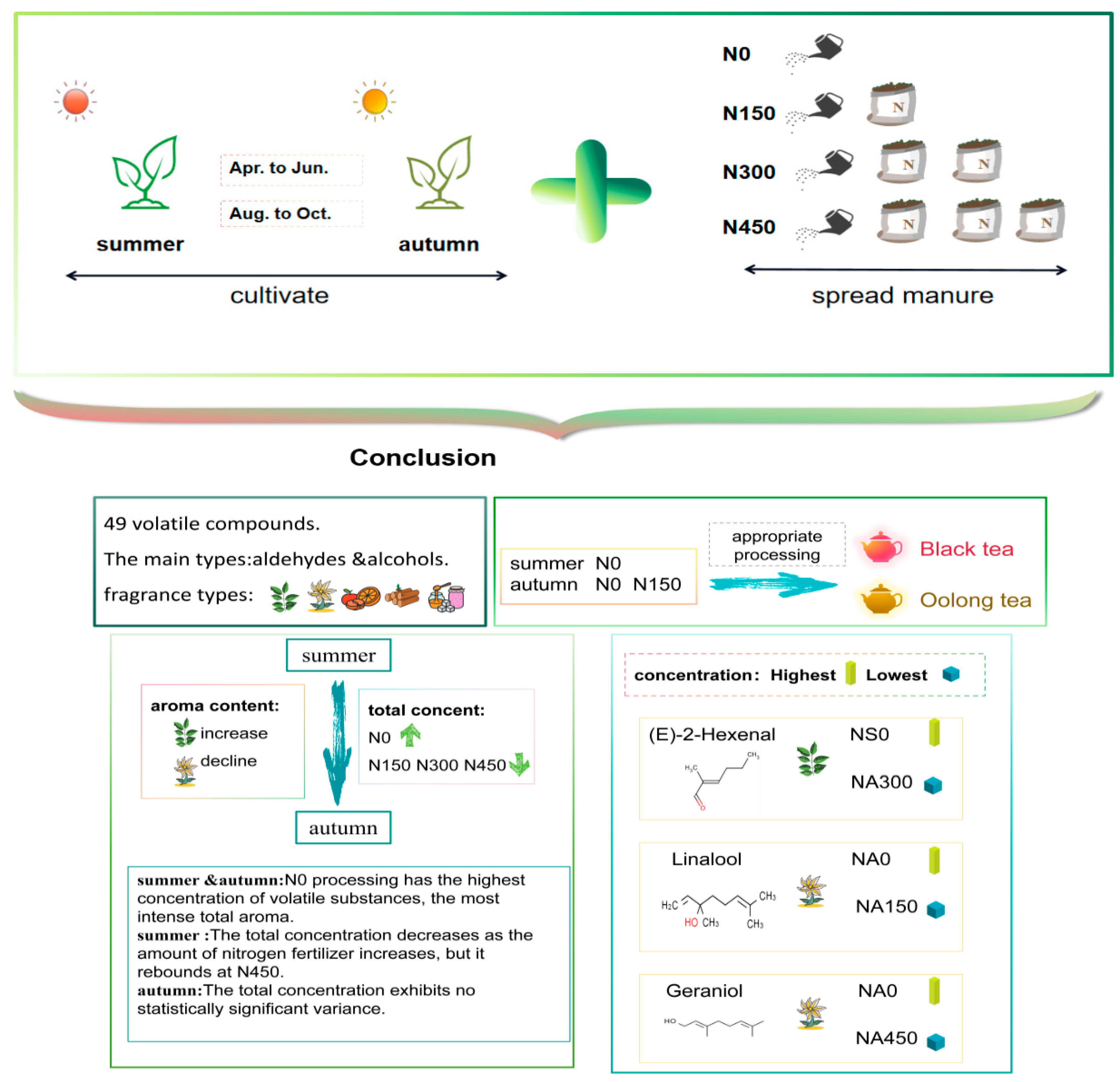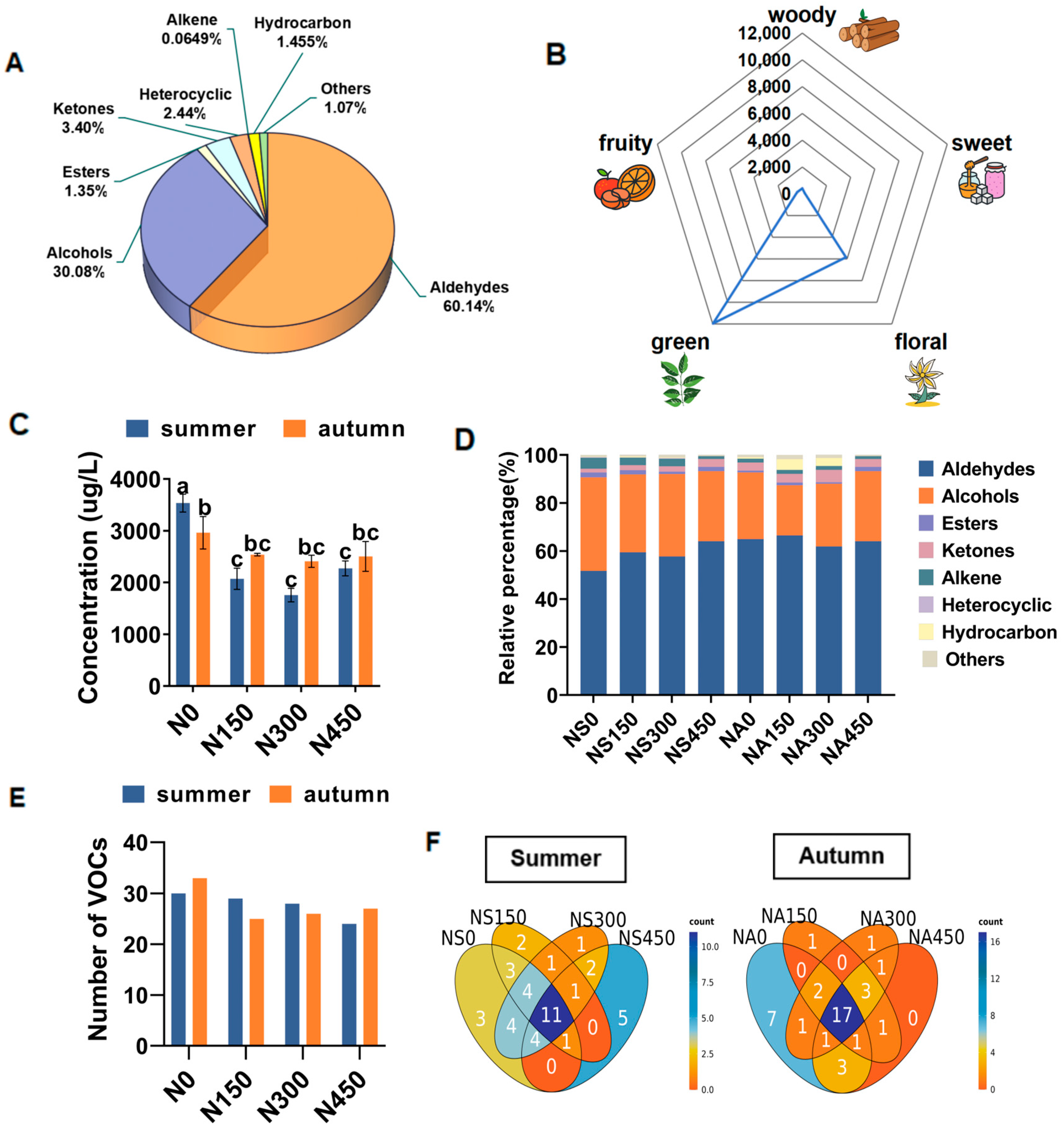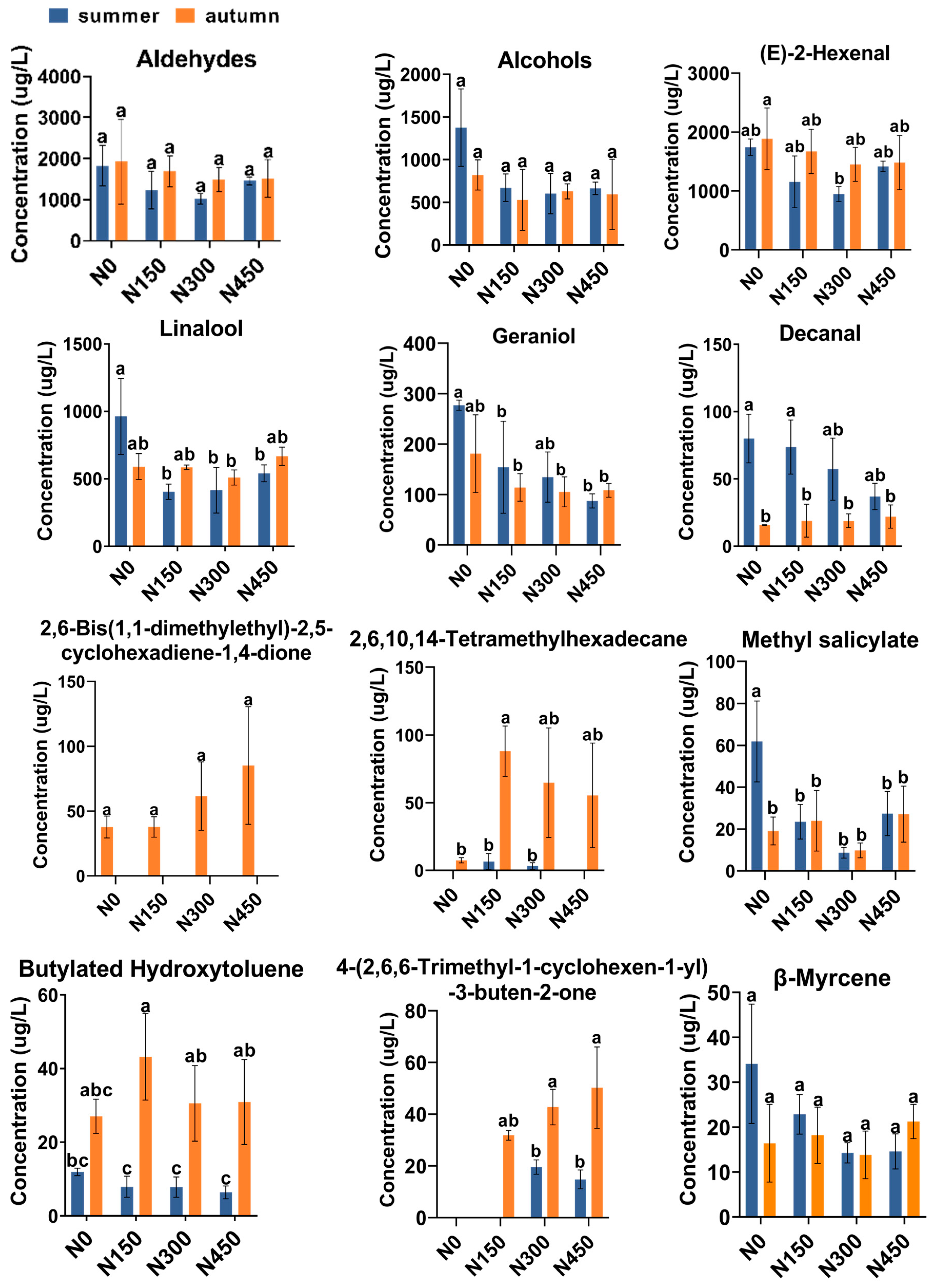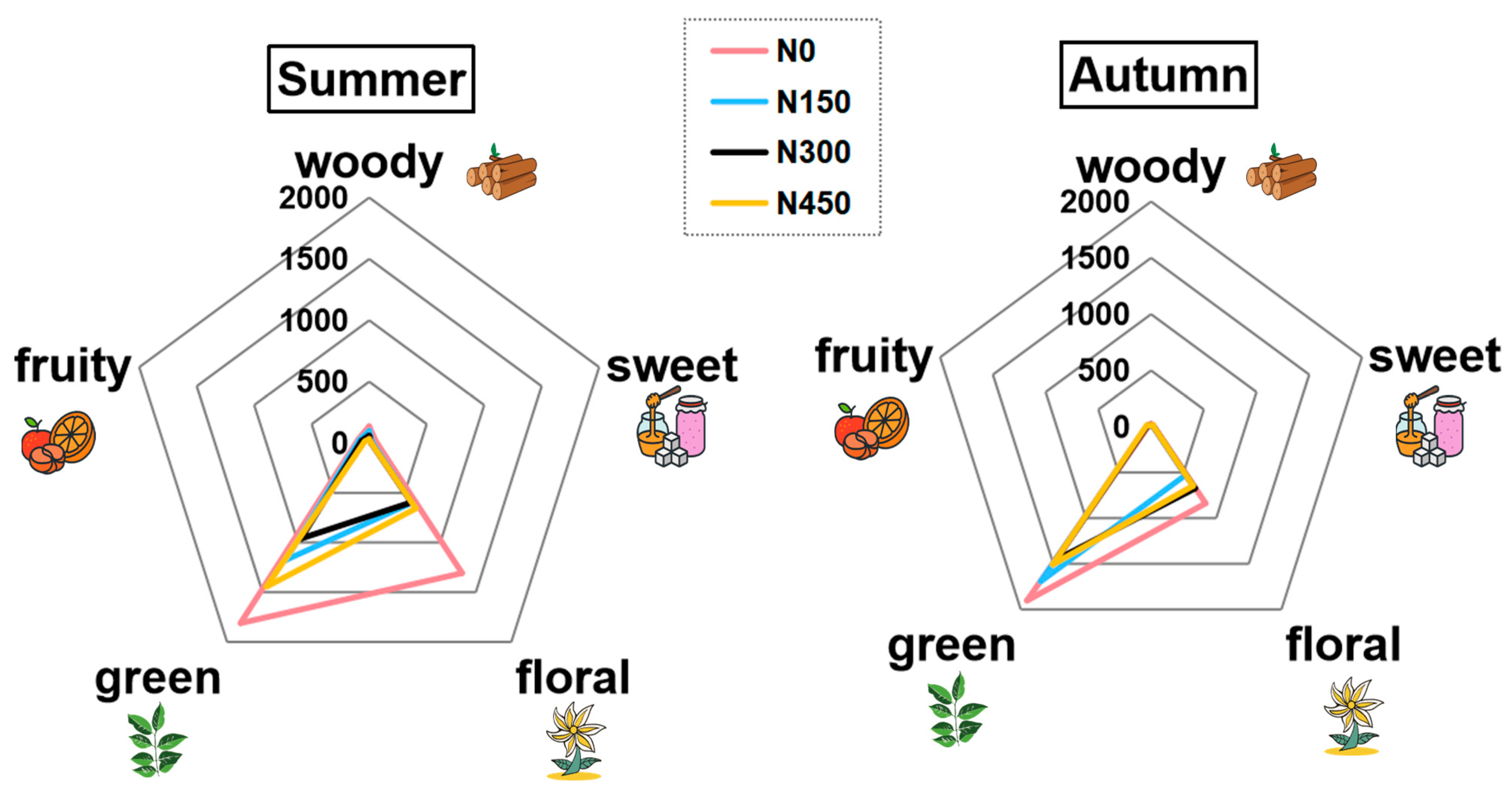The Effects of Nitrogen Fertilizer on the Aroma of Fresh Tea Leaves from Camellia sinensis cv. Jin Xuan in Summer and Autumn
Abstract
1. Introduction
2. Materials and Methods
2.1. Chemicals and Reagents
2.2. Experimental Design and Collection of Tea Samples
2.3. Extraction of Volatiles Utilizing Head Space Solid-Phase Microextraction Gas Chromatography (HS-SPME GC)
2.4. GC-MS Analysis of Volatile Compounds
2.5. Calculation of Odor Activity Values (OAVs)
2.6. Statistical Analysis
3. Results and Discussion
3.1. Identification and Comprehensive Comparison of Volatiles
3.2. Comparison of the Volatiles Found in Fresh JX Leaves in Summer and Autumn under the Same N Treatment
3.3. Volatile Components of Fresh JX Leaves in Summer under the Different N Treatments
3.4. Volatile Components of Fresh JX Leaves in Autumn under the Different N Treatments
3.5. Multivariate Analysis of Volatiles in Fresh JX Leaves in Summer
| Var. No. | Volatile Compounds | Odor Type | VIP 1 | OT 2 (µg/kg) | OAVs in N Treatments | |||
|---|---|---|---|---|---|---|---|---|
| N0 | N150 | N300 | N450 | |||||
| Var_1 | (E)-2-hexenal | Fresh, fruity, green | 3.22 | 110 a | 15.83 | 10.49 | 8.60 | 12.88 |
| Var_4 | Linalool | Floral, sweet | 2.65 | 0.22 b | 4379.73 | 1842.73 | 1892.82 | 2460.45 |
| Var_11 | Geraniol | Rose-like, sweet, honey-like | 2.11 | 0.6 a | 461.98 | 256.7 | 224.43 | 145.6 |
| Var_9 | Decanal | Citrus, fatty, green | 1.37 | 9 a | 8.89 | 8.18 | 6.36 | 4.10 |
| Var_8 | Methyl salicylate | Peppermint, minty, fresh, sweet | 1.27 | 40 a | 1.55 | 0.59 | 0.22 | 0.68 |
| Var_32 | (3R,6S)-2,2,6-trimethyl-6-vinyltetrahydro-2H-pyran-3-ol | Woody | 1.25 | 3000 c | 0.00 | 0.01 | 0.01 | 0.01 |
| Var_37 | 2,6,6-trimethyl-1-cyclohexene-1-carboxaldehyde | Herbal, clean, rose-like, fruity | 1.07 | 5 d | 0.00 | 0.00 | 2.30 | 0.00 |
| Var_12 | α-Cubebene | Herbal waxy | 1.02 | 14 e | 1.31 | 0.00 | 0.67 | 0.00 |
| Var_20 | trans-β-ionone | Violet | 1.00 | 0.01 f,g | 2838.00 | 1380.00 | 0.00 | 0.00 |
3.6. Multivariate Analysis of Volatiles in Fresh JX Leaves in Autumn
4. Conclusions
Supplementary Materials
Author Contributions
Funding
Institutional Review Board Statement
Informed Consent Statement
Data Availability Statement
Conflicts of Interest
References
- Wang, J.Q.; Fu, Y.Q.; Chen, J.X.; Wang, F.; Feng, Z.H.; Yin, J.F.; Zeng, L.; Xu, Y.Q. Effects of baking treatment on the sensory quality and physicochemical properties of green tea with different processing methods. Food Chem. 2022, 380, 132217. [Google Scholar] [CrossRef] [PubMed]
- Wong, M.; Sirisena, S.; Ng, K. Phytochemical profile of differently processed tea: A review. J. Food Sci. 2022, 87, 1925–1942. [Google Scholar] [CrossRef] [PubMed]
- Chen, S.; Li, X.; Liu, Y.; Chen, J.; Ma, J.; Chen, L. Identification of QTL controlling volatile terpene contents in tea plant (Camellia sinensis) using a high-aroma ‘Huangdan’ x ‘Jinxuan’ F(1) population. Front. Plant Sci. 2023, 14, 1130582. [Google Scholar] [CrossRef] [PubMed]
- Zeng, L.; Jin, S.; Xu, Y.; Granato, D.; Fu, Y.; Sun, W.; Yin, J.; Xu, Y. Exogenous stimulation-induced biosynthesis of volatile compounds: Aroma formation of oolong tea at postharvest stage. Crit. Rev. Food Sci. 2022, 64, 11. [Google Scholar] [CrossRef] [PubMed]
- Zhai, X.; Zhang, L.; Granvogl, M.; Ho, C.; Wan, X. Flavor of tea (Camellia sinensis): A review on odorants and analytical techniques. Compr. Rev. Food Sci. Food Saf. 2022, 21, 3867–3909. [Google Scholar] [CrossRef] [PubMed]
- Li, M.; Ho, C.; Wang, J.; Hu, Y.; Zhai, X.; Zhang, L.; Wan, X.; Yang, X. Formation of Volatile Heterocyclic Compounds and Open-Chain Amides of Theanine in Model Systems with Glucose, Tea Leaves, and Tea Extract under Tea—Roasting Conditions. J. Agric. Food Chem. 2022, 70, 6737–6746. [Google Scholar] [CrossRef] [PubMed]
- Chen, Q.; Zhu, Y.; Dai, W.; Lv, H.; Mu, B.; Li, P.; Tan, J.; Ni, D.; Lin, Z. Aroma formation and dynamic changes during white tea processing. Food Chem. 2019, 274, 915–924. [Google Scholar] [CrossRef] [PubMed]
- Chen, X.; Chen, D.; Jiang, H.; Sun, H.; Zhang, C.; Zhao, H.; Li, X.; Yan, F.; Chen, C.; Xu, Z. Aroma characterization of Hanzhong black tea (Camellia sinensis) using solid phase extraction coupled with gas chromatography-mass spectrometry and olfactometry and sensory analysis. Food Chem. 2019, 274, 130–136. [Google Scholar] [CrossRef]
- Benti, T.; Debela, A.; Bekele, Y.; Suleman, S. Influence of clone and nitrogen application level on quality of green tea in some selected tea (Camellia sinensis (L.) O. Kuntze) in Southwest Ethiopia. Heliyon 2022, 8, e10179. [Google Scholar]
- Feng, L.; Yang, T.; Zhang, Z.; Li, F.; Chen, Q.; Sun, J.; Shi, C.; Deng, W.; Tao, M.; Tai, Y.; et al. Identification and characterization of cationic amino acid transporters (CATs) in tea plant (Camellia sinensis). Plant Growth Regul. 2018, 84, 57–69. [Google Scholar] [CrossRef]
- Zhang, G.; Yang, J.; Cui, D.; Zhao, D.; Li, Y.; Wan, X.; Zhao, J. Transcriptome and Metabolic Profiling Unveiled Roles of Peroxidases in Theaflavin Production in Black Tea Processing and Determination of Tea Processing Suitability. J. Agric. Food Chem. 2020, 68, 3528–3538. [Google Scholar] [CrossRef] [PubMed]
- Zeng, L.; Zhou, X.; Su, X.; Yang, Z. Chinese oolong tea: An aromatic beverage produced under multiple stresses. Trends Food Sci. Technol. 2020, 106, 242–253. [Google Scholar] [CrossRef]
- Liu, M.; Burgos, A.; Ma, L.; Zhang, Q.; Tang, D.; Ruan, J. Lipidomics analysis unravels the effect of nitrogen fertilization on lipid metabolism in tea plant (Camellia sinensis L.). BMC Plant Biol. 2017, 17, 165. [Google Scholar] [CrossRef] [PubMed]
- Li, T.; Li, T.; Zhang, Y.; Schmidt, R.R.; Peng, P. Preparation of Tea Aroma Precursor Glycosides: An Efficient and Sustainable Approach via Chemical Glycosidation. J. Agric. Food Chem. 2022, 70, 2320–2327. [Google Scholar] [CrossRef] [PubMed]
- Wang, Y.; Liu, Y.; Zhuo, Z.; Xue, J.; Xu, R.; Sun, L.; Liao, H. Effects of high nitrogen, low phosphorus, and medium potassium ratios on yield and quality of Wuyi rock tea. South. Agric. J. 2022, 53, 391–400. (In Chinese) [Google Scholar]
- Bryant, J.P.; Chapin III, F.S.; Klein, D.R. Carbon/nutrient balance of boreal plants in relation to vertebrate herbivory. Oikos 1983, 40, 357–368. [Google Scholar] [CrossRef]
- Guo, X.; Ho, C.; Schwab, W.; Song, C.; Wan, X. Aroma compositions of large-leaf yellow tea and potential effect of theanine on volatile formation in tea. Food Chem. 2019, 280, 73–82. [Google Scholar] [CrossRef] [PubMed]
- Ma, B.; Wang, J.; Zhou, B.; Wang, Z.; Huang, Y.; Ma, C.; Li, X. Impact of harvest season on bioactive compounds, amino acids and in vitro antioxidant capacity of white tea through multivariate statistical analysis. LWT-Food Sci. Technol. 2022, 164, 113655. [Google Scholar] [CrossRef]
- Flaig, M.; Qi, S.; Wei, G.; Yang, X.; Schieberle, P. Characterization of the Key Odorants in a High-Grade Chinese Green Tea Beverage (Camellia sinensis; Jingshan cha) by Means of the Sensomics Approach and Elucidation of Odorant Changes in Tea Leaves Caused by the Tea Manufacturing Process. J. Agric. Food Chem. 2020, 68, 5168–5179. [Google Scholar] [CrossRef]
- Qiu, Z.; Liao, J.; Chen, J.; Li, A.; Lin, M.; Liu, H.; Huang, W.; Sun, B.; Liu, J.; Liu, S. Comprehensive analysis of fresh tea (Camellia sinensis cv. Lingtou Dancong) leaf quality under different nitrogen fertilization regimes. Food Chem. 2023, 439, 138127. [Google Scholar] [CrossRef]
- Flaig, M.; Qi, S.C.; Wei, G.; Yang, X.; Schieberle, P. Characterisation of the key aroma compounds in a Longjing green tea infusion (Camellia sinensis) by the sensomics approach and their quantitative changes during processing of the tea leaves. Eur. Food Res. Technol. 2020, 246, 2411–2425. [Google Scholar] [CrossRef]
- Zhu, J.C.; Chen, F.; Wang, L.Y.; Niu, Y.W.; Yu, D.; Shu, C.; Chen, H.X.; Wang, H.L.; Xiao, Z.B. Comparison of Aroma-Active Volatiles in Oolong Tea Infusions Using GC-Olfactometry, GC-FPD, and GC-MS. J. Agric. Food Chem. 2015, 63, 7499–7510. [Google Scholar] [CrossRef]
- Zhu, J.C.; Niu, Y.; Xiao, Z.B. Characterization of the key aroma compounds in Laoshan green teas by application of odour activity value (OAV), gas chromatography-mass spectrometry-olfactometry (GC-MS-O) and comprehensive two-dimensional gas chromatography mass spectrometry (GC × GC-qMS). Food Chem. 2021, 339, 128136. [Google Scholar] [CrossRef] [PubMed]
- Xiao, Z.; Wang, H.; Niu, Y.; Liu, Q.; Zhu, J.; Chen, H.; Ma, N. Characterization of aroma compositions in different Chinese congou black teas using GC–MS and GC–O combined with partial least squares regression. Flavour Frag. J. 2017, 32, 265–276. [Google Scholar] [CrossRef]
- Qiao, R.; Zheng, X.; Li, Q.; Liang, Y. Research advances in aromatic volatiles of various teas. J. Tea 2016, 42, 135–142. (In Chinese) [Google Scholar]
- Wang, Q.; Jiang, X.; Qin, D.; Liu, S.; Wu, H. Metabolic profiling of flavor compounds in black teas with almond odor during processing. Eur. Food Res. Technol. 2020, 246, 2039–2053. [Google Scholar] [CrossRef]
- Wang, X.; Cao, J.; Cheng, X.; Liu, X.; Zhu, W.; Li, Y.; Wan, X.; Chen, S.; Liu, L. UV-B application during the aeration process improves the aroma characteristics of oolong tea. Food Chem. 2024, 435, 137585. [Google Scholar] [CrossRef] [PubMed]
- Wang, B.; Chen, H.; Qu, F.; Song, Y.; Di, T.; Wang, P.; Zhang, X. Identification of aroma—Active components in black teas produced by six Chinese tea cultivars in high—Latitude region by GC–MS and GC–O analysis. Eur. Food Res. Technol. 2022, 248, 647–657. [Google Scholar] [CrossRef]
- Mi, S.; Han, S.; Wang, M.; Han, B. Comprehensive analysis of the effect of etiolated tea cultivars and harvest seasons on volatile compounds and in vitro antioxidant capacity in steamed green teas. Food Chem. X 2024, 22, 101279. [Google Scholar] [CrossRef]
- Liu, H.; Xu, Y.; Wu, J.; Wen, J.; Yu, Y.; An, K.; Zou, B. GC-IMS and olfactometry analysis on the tea aroma of Yingde black teas harvested in different seasons. Food Res. Int. 2021, 150, 110784. [Google Scholar] [CrossRef]
- Yu, P.; Huang, Y.; Li, Z.; Zhao, X.; Huang, H.; Zhong, N.; Zheng, H.; Chen, Q. Difference in Aroma Components of Black Teas Processed on Different Dates in the Spring Season. Foods 2023, 12, 4368. [Google Scholar] [CrossRef]
- Zheng, T.; Zhang, L. Effects of Different Harvest Seasons on the Aroma Quality of Re-fermented Sheng Pu-erh Tea. MFST 2007, 11, 1534. (In Chinese) [Google Scholar]
- Liu, H.; Xu, Y.; Wen, J.; An, K.; Wu, J.; Yu, Y.; Zou, B.; Guo, M. A comparative study of aromatic characterization of Yingde Black Tea infusions in different steeping temperatures. LWT 2021, 143, 110860. [Google Scholar] [CrossRef]
- Xiao, Y.; Tan, H.; Huang, H.; Yu, J.; Zeng, L.; Liao, Y.; Wu, P.; Yang, Z. Light synergistically promotes the tea green leafhopper infestation-induced accumulation of linalool oxides and their glucosides in tea (Camellia sinensis). Food Chem. 2022, 394, 133460. [Google Scholar] [CrossRef] [PubMed]
- Wang, J.; Wu, B.; Zhang, N.; Zhao, M.; Jing, T.; Wu, Y.; Hu, Y.; Yu, F.; Wan, X.; Schwab, W. Dehydration-induced carotenoid cleavage dioxygenase 1 reveals a novel route for β-ionone formation during tea (Camellia sinensis) withering. J. Agric. Food Chem. 2020, 68, 10815–10821. [Google Scholar] [CrossRef] [PubMed]
- Guo, X.; Ho, C.; Schwab, W.; Wan, X. Effect of the roasting degree on flavor quality of large-leaf yellow tea. Food Chem. 2021, 347, 129016. [Google Scholar] [CrossRef] [PubMed]
- Hao, Z.; Feng, J.; Chen, Q.; Lin, H.; Zhou, X.; Zhuang, J.; Wang, J.; Tan, Y.; Sun, Z.; Wang, Y. Comparative volatiles profiling in milk-flavored white tea and traditional white tea Shoumei via HS-SPME-GC-TOFMS and OAV analyses. Food Chem. X 2023, 18, 100710. [Google Scholar] [CrossRef]
- Hou, Z.; Wang, Y.; Xu, S.; Wei, Y.; Bao, G.; Dai, Q.; Deng, W.; Ning, J. Effects of dynamic and static withering technology on volatile and nonvolatile components of Keemun black tea using GC-MS and HPLC combined with chemometrics. LWT 2020, 130, 109547. [Google Scholar] [CrossRef]
- Liu, P.; Feng, L.; Xu, Y.; Zheng, L.; Yin, P.; Ye, F.; Gui, A.; Wang, S.; Wang, X.; Teng, J. Characterization of stale odor in green tea formed during storage: Unraveling improvements arising from reprocessing by baking. LWT 2023, 174, 114458. [Google Scholar] [CrossRef]
- Wang, M.; Li, J.; Liu, X.; Liu, C.; Qian, J.; Yang, J.; Zhou, X.; Jia, Y.; Tang, J.; Zeng, L. Characterization of key odorants in Lingtou Dancong oolong tea and their differences induced by environmental conditions from different altitudes. Metabolites 2022, 12, 1063. [Google Scholar] [CrossRef]
- Wu, H.; Chen, Y.; Feng, W.; Shen, S.; Wei, Y.; Jia, H.; Wang, Y.; Deng, W.; Ning, J. Effects of Three Different Withering Treatments on the Aroma of White Tea. Foods 2022, 11, 2502. [Google Scholar] [CrossRef] [PubMed]
- Yin, P.; Wang, J.; Kong, Y.; Zhu, Y.; Zhang, J.; Liu, H.; Wang, X.; Guo, G.; Wang, G.; Liu, Z. Dynamic changes of volatile compounds during the Xinyang Maojian green tea manufacturing at an industrial scale. Foods 2022, 11, 2682. [Google Scholar] [CrossRef] [PubMed]
- Zhang, W.; Cao, J.; Li, Z.; Li, Q.; Lai, X.; Sun, L.; Chen, R.; Wen, S.; Sun, S.; Lai, Z. HS-SPME and GC/MS volatile component analysis of Yinghong No. 9 dark tea during the pile fermentation process. Food Chem. 2021, 357, 129654. [Google Scholar] [CrossRef] [PubMed]





| Var. No. | Volatile Compounds | Odor Type | VIP 1 | OT 2 (µg/kg) | OAVs in N Treatments | |||
|---|---|---|---|---|---|---|---|---|
| N0 | N150 | N300 | N450 | |||||
| Var_1 | (E)-2-hexenal | Fresh, fruity, green | 3.30 | 110 a | 17.14 | 98.23 | 85.32 | 87.13 |
| Var_4 | Linalool | Floral, sweet | 2.41 | 0.22 b | 2686.59 | 1778.55 | 2322.23 | 2098.82 |
| Var_37 | 2,6,6-trimethyl-1-cyclohexene-1-carboxaldehyde | Herbal, clean, rose-like, fruity | 1.27 | 5 d | 3.46 | 0.00 | 3.10 | 1.88 |
| Var_3 | β-Ocimene | Sweet, floral | 1.16 | 10 h | 0.00 | 0.00 | 0.74 | 0.00 |
| Var_10 | (Z)-2,6-Octadien-1-ol, 3,7-dimethyl- | Fresh, citrus, floral, green, lemon-like | 1.14 | 53 d | 0.18 | 0.74 | 0.13 | 0.17 |
| Var_8 | Methyl salicylate | Peppermint, minty, fresh, sweet | 1.06 | 40 a | 0.48 | 0.60 | 0.25 | 0.68 |
Disclaimer/Publisher’s Note: The statements, opinions and data contained in all publications are solely those of the individual author(s) and contributor(s) and not of MDPI and/or the editor(s). MDPI and/or the editor(s) disclaim responsibility for any injury to people or property resulting from any ideas, methods, instructions or products referred to in the content. |
© 2024 by the authors. Licensee MDPI, Basel, Switzerland. This article is an open access article distributed under the terms and conditions of the Creative Commons Attribution (CC BY) license (https://creativecommons.org/licenses/by/4.0/).
Share and Cite
Li, A.; Qiu, Z.; Liao, J.; Chen, J.; Huang, W.; Yao, J.; Lin, X.; Huang, Y.; Sun, B.; Liu, S.; et al. The Effects of Nitrogen Fertilizer on the Aroma of Fresh Tea Leaves from Camellia sinensis cv. Jin Xuan in Summer and Autumn. Foods 2024, 13, 1776. https://doi.org/10.3390/foods13111776
Li A, Qiu Z, Liao J, Chen J, Huang W, Yao J, Lin X, Huang Y, Sun B, Liu S, et al. The Effects of Nitrogen Fertilizer on the Aroma of Fresh Tea Leaves from Camellia sinensis cv. Jin Xuan in Summer and Autumn. Foods. 2024; 13(11):1776. https://doi.org/10.3390/foods13111776
Chicago/Turabian StyleLi, Ansheng, Zihao Qiu, Jinmei Liao, Jiahao Chen, Wei Huang, Jiyuan Yao, Xinyuan Lin, Yuwang Huang, Binmei Sun, Shaoqun Liu, and et al. 2024. "The Effects of Nitrogen Fertilizer on the Aroma of Fresh Tea Leaves from Camellia sinensis cv. Jin Xuan in Summer and Autumn" Foods 13, no. 11: 1776. https://doi.org/10.3390/foods13111776
APA StyleLi, A., Qiu, Z., Liao, J., Chen, J., Huang, W., Yao, J., Lin, X., Huang, Y., Sun, B., Liu, S., & Zheng, P. (2024). The Effects of Nitrogen Fertilizer on the Aroma of Fresh Tea Leaves from Camellia sinensis cv. Jin Xuan in Summer and Autumn. Foods, 13(11), 1776. https://doi.org/10.3390/foods13111776





